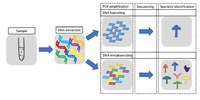
Photo from wikipedia
Abstract Characterizing the diet of imperiled species using minimally invasive methods is crucial to understanding their ecology and conservation requirements. Here, we apply a DNA metabarcoding approach to study the… Click to show full abstract
Abstract Characterizing the diet of imperiled species using minimally invasive methods is crucial to understanding their ecology and conservation requirements. Here, we apply a DNA metabarcoding approach to study the diet of the eastern massasauga rattlesnake (Sistrurus catenatus), a Federally Threatened snake found throughout the Great Lakes region. Eighty‐three fecal samples collected across 10 different massasauga populations located in Michigan, USA, were sequenced, with 70 samples containing prey DNA. We used universal metazoan primers and developed a host‐specific oligonucleotide blocker to characterize their diet. We identified at least 12 different prey species, with eastern massasaugas exhibiting opportunistic feeding and a strong preference towards small mammals. Meadow voles (Microtus pennsylvanicus) were the most common prey item (70% of diet) followed by the northern short‐tailed shrew (Blarina brevicauda) and masked shrew (Sorex cinereus; 15.7% of diet each), along with occasional bird and snake prey. Adult individuals exhibited a more generalized diet, consuming a larger number of prey taxa on average. Younger snakes consumed a smaller variety of prey items and tended to consume smaller‐sized mammals such as masked shrews (Sorex cinereus) and northern short‐tailed shrews (Blarina brevicauda). We conclude that small mammals are a crucial part of eastern massasauga rattlesnake diet and recommend this be taken into consideration when conservation strategies are developed. The methods developed in this study can be applied to other reptile species, providing an accurate, minimally invasive, and thorough diet assessment for at‐risk reptile species.
Journal Title: Ecology and Evolution
Year Published: 2023
Link to full text (if available)
Share on Social Media: Sign Up to like & get
recommendations!